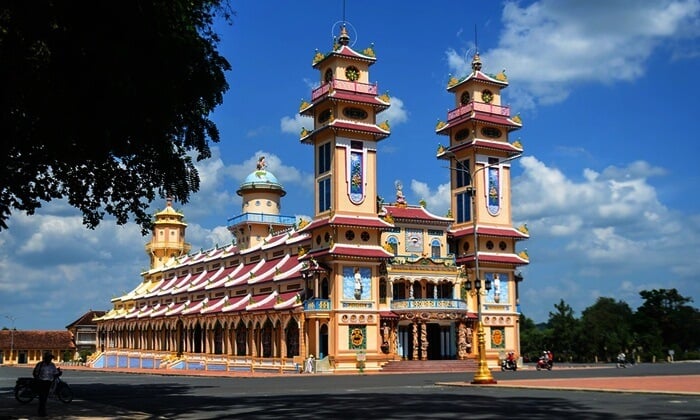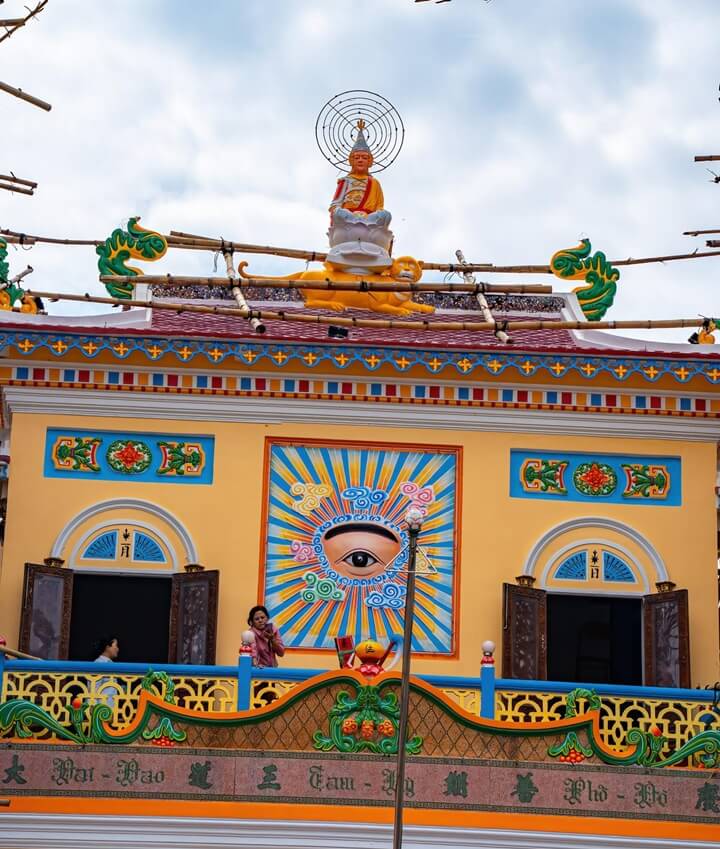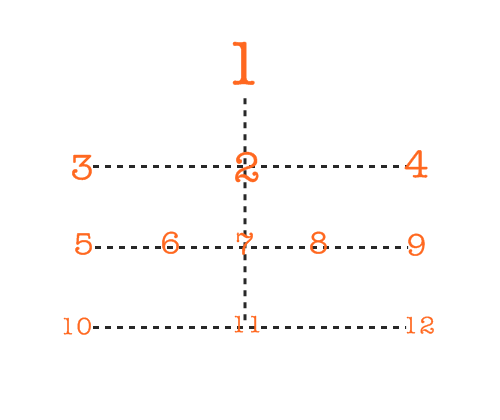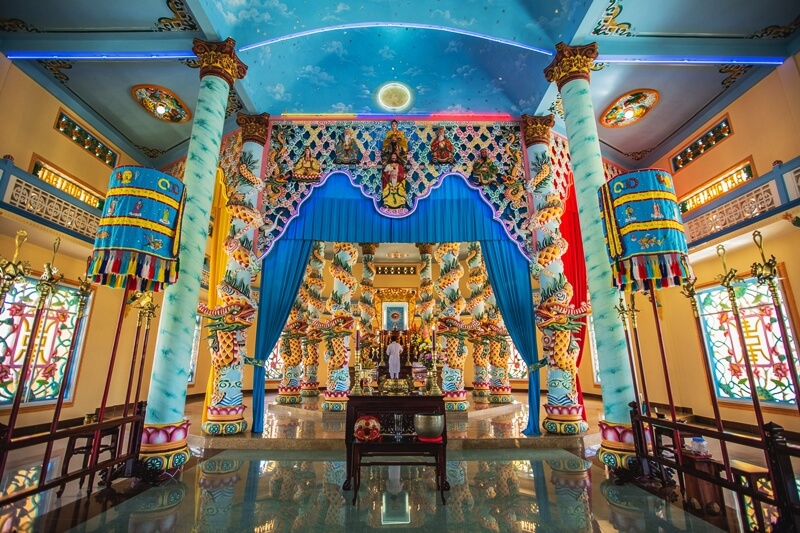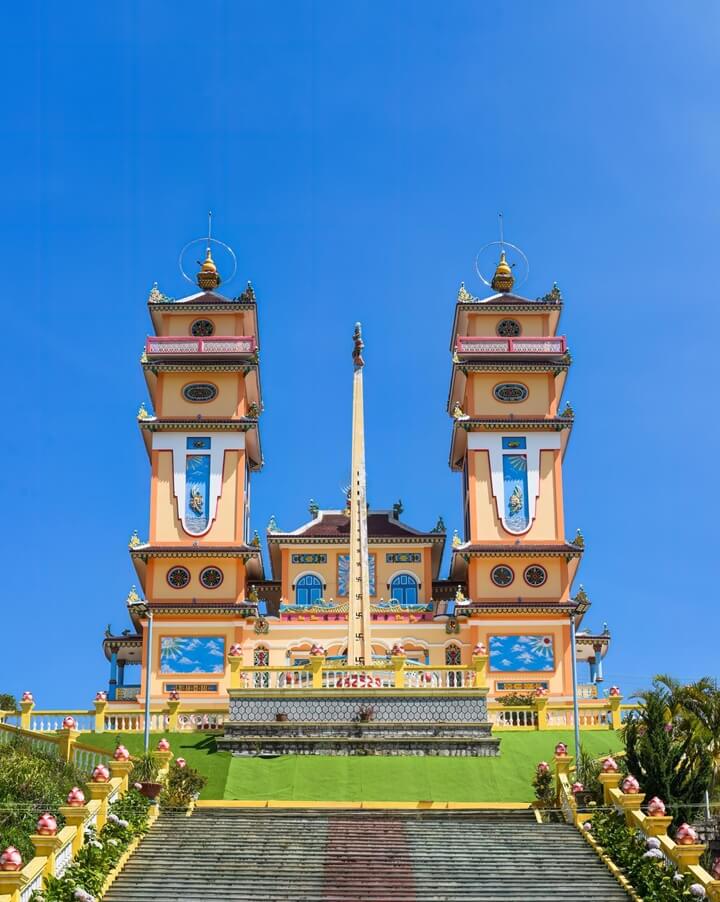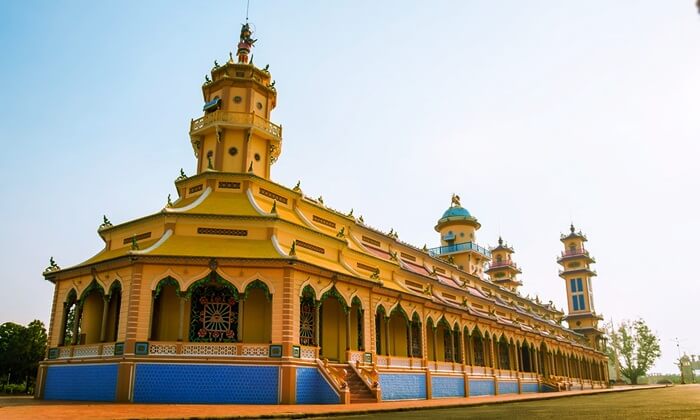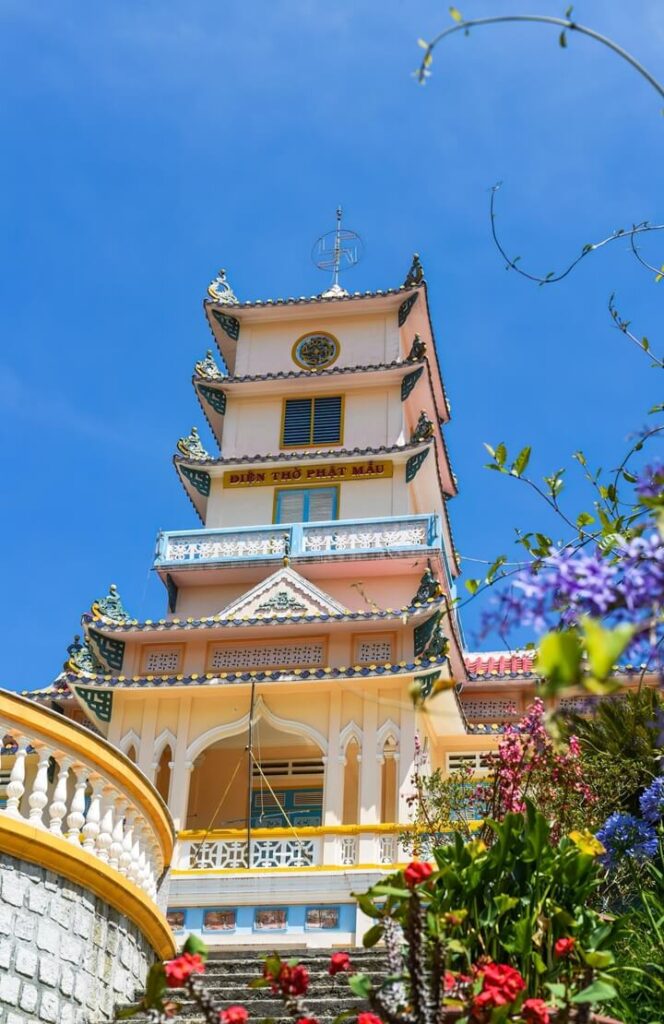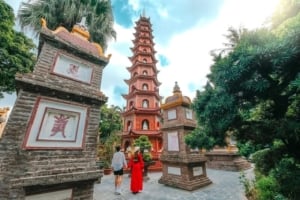Caodaism is the short name of an indigenous religion in Vietnam, whose full name is Dai Dao Tam Ky Pho Do.
The name of Cao Dai means a high place, figuratively the highest place where God resides. Some Cao Dai followers often call their religion Dao Troi to show respect.
The Cao Dai religion was founded in 1926 in the southern part of Vietnam. Mr. Ngo Minh Chieu was the first follower.
Not only did it develop in the South, but followers of Cao Dao traveled to all regions of the country to spread and form centers for worship and spiritual activities.
Caodaism symbol
Cao Dai worships God with the image of the left Eye, called Thien Nhan – Heaven Eye, which becomes the symbol of this religion.
Heaven’s Eye is the manifestation of the monitoring and controlling power of the universe. The supreme power is God.
Thien Nhan also signifies sympathy between humans and the universe, which has a very important meaning for Cao Dai followers. It reminds believers that every gesture and action is always under the scrutiny of God.
It is said that the God of Cao Dai is the heaven god, forming in the Eye to look at the universe.
The saying, “Heaven has eyes,” indicates that God clearly sees all the good and evil deeds of all sentient beings, whether revealed to the outside or hidden inside. An opening eye always reminds us that whatever we do, God can see it clearly, and it can’t be hidden.
Worshiping Thien Nhan (a heaven eye) means Dai Dong (all in one). Any group or nation knows how to draw the Eye to worship, and drawing the eye image is not racist, so it has a general feature that is all in one.
What does Caodaism worship?
Cao Dai worships Heaven God with the image of the left Eye, called Thien Nhan. Besides, Cao Dai also worships the cardinals of other religions.
On the altar of the Cao Dai religion, under Thien Nhan (heaven eye), are Thich Ca, Lao Tzu, Confucius (Three Religions), Quan Am, Ly Thai Bach, Quan Thanh (Three Tran), Jesus Christ, and Khuong Thai Cong, all including 08 people.
The altar of Cao Dai is called Thien Ban (Heaven Alter). The placement of Thien Ban may be the same as the worshiper’s ancestral altar. Or it can be placed in a separate, dignified place in each family.
The Cao Dai altar is usually made of wood and built into two floors. There must be 9 – 11 main dishes and things on the table and arranged in 3 horizontal rows.
The layout diagram of the Cao Dai altar with the basics as below:
- 1. One eye statue
- 2. Tai Chi lamp/light
- 3. Fruits
- 4. Flowers
- 5. Teacup (to the right side is Yin).
- 6 – 7 – 8. Three glasses of wine
- 9. Water cup (to the left side be Yang).
- 10 and 12. Two light/candle
- 11. Incense burner
Why is there only one eye, not two?
Worshipping one eye, not two, shows that is the initial number of the universe, which starts creating every number and everything.
Therefore, the number 1 is the foundation, the number is Yang. Also, the supreme being is the owner of the Yang light (light of the sun).
Why is the left eye not the right?
The left Eye belongs to Yang, and the right side belongs to Yin. This means the wish is to develop strongly, lighting a good way for the public.
So, when entering the Caodaist temple, the male people kneel on the left of God (the Eye and Global), and the female people kneel on the right. This shows that Yin-Yang (male left, female right) does not distinguish gender as many think.
Cao dai beliefs
Cao Dai followers believe God is the founder of religions and the universe. The heaven god directly designates all teachings, symbolic systems, and organizations.
Heaven God directly enlightens Cao Dai’s religion for believers with the task of Dai Dao Tam Ky Pho Do, which means a great way to save suffering for the third period.
When God enlightens followers, a ceremony called “Cơ bút” is the ritual of praying for and writing, which is a foundation of the Cao Dai religion. This method is said to have given birth and is a means of propagating this religion.
The three levels of creating the religion of Heaven God are as follows:
- The first period of the beginning: This was the first period when significant religions were formed, namely Buddhism, Confucianism, Jainism, and Taoism. Heaven God entrusted his first disciples to preach to the people.
- The second universal period: This duration revives all religions present in the world. After the beginning of the development of universal salvation, the teachings did not correctly teach the principles that God desired. Therefore, Heaven God once again taught his disciples worldwide and formed Mahayana Buddhism, Hinayana Buddhism, and others. Thanks to that, religions in this period were revived and developed very strongly, overcoming the barriers of regions and countries.
- The third period of universality: In this period, all religions present in the world were united by God into a single religion. And the Heaven God who will directly run and govern. This is also why many Caodist followers call their present theory “Dao Troi” or “Dao Thay.” The intention implies that they are those who receive direct instruction from God. The believers believe the Dao Cao religion is set at the third level.
In general, believers in the religion follow the basic rules of the religion, such as living honestly, not killing, praying, and worshiping ancestors and grandparents.
That is shown through fasting and reciting religious teachings every day. All want to bring prosperity and happiness to all species. The ultimate goal is to get all things out of the cycle of reincarnation to the heavenly realm.
Cao Dai Origin
Cao Dai is said to be a new religion, and it brings together many elements from all major religions in Vietnam, including Buddhism.
According to belief, every religion cannot cover all aspects of life; there are good and not right sides. Therefore, the Cao Dai religion was born to merge many good points of religion to create this unique one.
In 1926, at the beginning of the 20th century, a special religion was born called Dai Dao Tam Ky Pho Do (translated: Great Religion in the Third Period to Save the Public), short for Cao Dai.
The original land where the Cao Dai religion originated was in the southern region of Vietnam, and the first main temple was in Tay Ninh Province.
The Main Cao Dai Temple
As the most prominent holy site of the Cao Dai religion, Tay Ninh Temple attracts millions of visitors and pilgrims annually.
Tay Ninh Temple was started construction in 1933 and officially inaugurated in 1955.
This building has a unique architectural design, combining East-West philosophical views and harmoniously synthesizing many spiritual factors.
The first impression for visitors when coming here is the image of Thien Nhan (Heaven Eye) right in front of the main temple, which is a glowing eye, a sacred symbol of the Cao Dai religion.
Experiencing many ups and downs over nearly one century, the Tay Ninh Temple has become a pilgrimage site for about 5 million followers around Vietnam and an attractive spiritual tourist attraction for many people.
Many foreign architectural magazines have written articles introducing and praising the Cao Dai Temple in Tay Ninh. The Tay Ninh people consider the temple the pride of their locality.
Does Caodaism have sacred texts or the bible?
The Cao Dai religion’s laws, rituals, and practices express faith, guiding worship, and practice.
The rules of Cao Dai were formed along with the birth process, both influenced by the laws and rituals of the Three Religions (Buddhism, Taoism, and Confucianism). Also, it was influenced by the customs of the traditional culture of the South.
The laws and rituals of the Cao Dai religion are presented in the textbooks, which are considered its bible: Dai Thua Chan Giao, Ngoc De Chan Truyen, Tan Luat, Phap Chanh Truyen, and Thanh Ngon Hiep Tuyen.
- Thanh Ngon Hiep Tuyen is a collection of religious teachings of the Jade Emperor God, Buddha, Fairy, Saint, and God through the medium of Co But (Old Pen).
- Phap Chanh Truyen carries the constitutional nature of religion, defining the mechanism of law-making, law enforcement, religious practice, and management of believers. This bible gives the duties, powers, and principles of selection.
- Tan Luat Book (The New Law Book) is a code of religion promulgated in 1927, consisting of three main parts: the part of the law that regulates the organization of the religion, rules of conduct, teaching, and discipline; the part of the law governs the behavior of believers with daily life such as family and social relations; Tinh Do (the pure house) section stipulates the conditions for entering the Pure House and the principles of living in the temple.
Some famous Cao Dai Temples in Vietnam:
Cao Dai spread around Vietnam; however, we do not have much information about this religion worldwide.
Buildings of Cao Dai have beautiful designs, and below are popular ones:
- Cao Dai Temple in Tay Ninh, built in 1926, Address: Pham Ho Phap Street, Hoa Thanh Town, Hoa Thanh District, Tay Ninh Province, Vietnam
- Chon Ly Temple, built 1928, Address: My Phong Commune, My Tho Province,
- Ben Tre Temple, 1934, Address: 100 Truong Dinh Street, Ward 6, Ben Tre Town.
- Chau Minh Temple, built in 1937 – 1956, Tien Thuy Commune, Chau Thanh District, Ben Tre Province
- Ngoc Sac Temple, built in 1933-1946, Phong Thanh Tay Commune, Gia Rai District, Bac Lieu Province
- Ngoc Kinh Temple, built in 1958, Address: Mong Tho B Commune, Chau Thanh District, Kien Giang Province.
- Chieu Minh Long Chau Temple, built in 1956, Address: Tan Phu Thanh Commune, Chau Thanh District, Can Tho Province.
- Cau Kho Temple was built in 1959 and rebuilt in 2007, Address: Tam Quan Commune, Hoai Nhon District, Binh Dinh Province.
- Trung Hung Buu Temple was constructed in 1956 at 63 Hai Phong Street, Da Nang City, Vietnam.
>>> You may want to see the best ancient temples in Vietnam.
How do you pronounce Caodaism?
Caodaism is “Đạo Cao Đài” in Vietnamese, pronounced like “doun – kou – dai”.
Is Cao Dai monotheistic or polytheistic?
Cao Dai is considered a monotheistic religion. The devotees worship a god, the Heaven God.
The globe depicts this God, who transforms into a single eye. The eye is not just a symbol but a revelation of the mystery, a manifestation of the universe’s monitoring and controlling power, which makes it a unique and intriguing aspect of Cao Dai worship.

